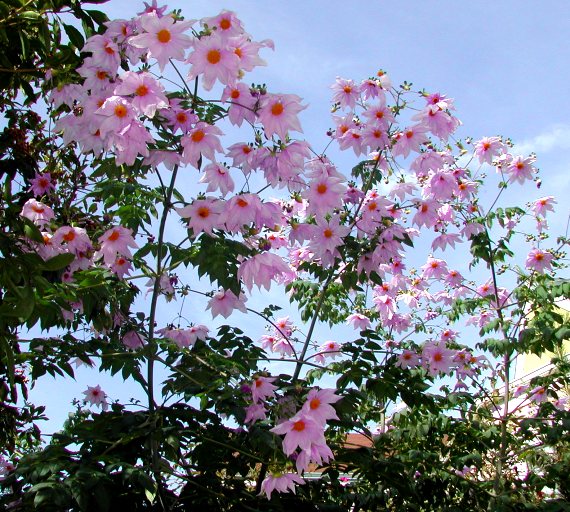Spectacular giant dahlia, it was grown in the Rose Garden at Monserrate (1923). Still to be found in (all too few) Sintra gardens.
Ortgies worked at the Zurich Botanic garden. He was the first to raise the plant in Europe. Nothing was known about the plant's natural habitat, other than that Roezl sent it from Mexico from whence the first tubers were received at the Zurich garden in 1862. The first plants flowered imperfectly because they were removed to a greenhouse when flowerbuds formed, in October. later plants were more successfully cultivated, producing flowers seven inches in diametre and forming a pyramid of flowers and foliage on thick bare stems fully twelve to eighteen feet high. A great challenge for the greenhouse gardener, others lacking the space for such a display resorted to the ingenious technique of grafting upon the root of a normal dahlia, obtaining inthis way more modest dimensions (six to eight feet) and still blooming luxuriantly.
notes and illustration from J. D. Hooker in Curtis's Botanical Magazine, (5813) 1870, vol. 96

A single plant of D. imperialis
Gardeners in warmer climates did not have to trouble with moving these giants under glass to protect the flowers. A notice in La Belgique horticole of 1867 gave notice of the plant grown in the open air at Hyéres by Charles Huber. Planted in May 1866, by November the plant had reached 4.5 metres. This was a white flowered clone. Abundant watering and feeding was advised as the key to success ... together with a stout stake!
But where does this dahlia really come from? The original description of 1838 says that it comes from the Valley of Mexico, where Mexico City is located, and that it had been long cultivated in the botanical gardens of that city. However there are no tree dahlias native to that locality. Benedict Roezl, a Czech gardener and botanist, who introduced the plant to Europe, travelled widely in Mexico and introduced many other plants. The location of his collection is unknown.
Today this plant is known from Chiapas in Southern Mexico until Guatemala, El Salvador and Costa Rica, down to Northern Columbia where it grows at elevations of 2,500 to 9000 feet. Its habitat is rocky slopes and fields. Local people use the cane like stems to form living fences - must be a spectacular sight.
Synonyms: Dahlia arborea, D. lehmannii, D. maximilliana, and D. maxonii. It is sometimes called eroneously D. excelsa which is a closely related species that is rarely cultivated.
Information from The Trees of Golden Gate Park and San Francisco by Elizabeth McClintock, 2001


No comments:
Post a Comment